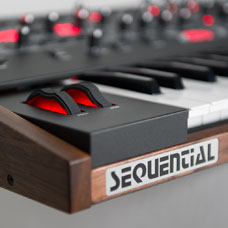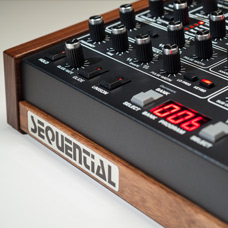The downloadable file in the sidebar at the right contains the latest operating system for the Prophet-6 keyboard and desktop module. It also includes the installation instructions given below.
When to Update Your OS
Most OS updates fix only minor bugs that most users never encounter. If you are experiencing a problem with your instrument, please contact Technical Support for help in diagnosing the cause before doing anything else. Unlike on computer, the OS on your instrument can never become corrupted, so re-installing your current OS won’t fix a hardware problem, and is not recommended. In addition, loading an OS improperly could disable your instrument, leaving it in need of servicing. So if you have any questions or are unsure about what you’re doing, please contact us before attempting to update your instrument’s operating system.
How to Update Your OS
The Prophet-6 operating system is updated via MIDI. You will need a DAW, MIDI utility,or other application capable of opening and sending MIDI System Exclusive (SysEx) messages. MIDI-OX (Windows) and SysEx Librarian (Mac OS) are shareware MIDI utilities that can reliably be used to update DSI instruments. You will also need either a USB cable (Type A to Type B connectors, like a typical USB printer cable) or a MIDI interface to transmit the SysEx file from your computer to the Prophet-6.
Instructions for updating using MIDI-OX and SysEx Librarian are given below.
The steps are:
I. CHECKING YOUR PROPHET-6 INSTALLED OS VERSION
II. UPDATING THE OS FROM WINDOWS USING MIDI-OX
III. UPDATING THE OS FROM A MAC USING SYSEX LIBRARIAN
I. CHECKING YOUR PROPHET-6 INSTALLED OS VERSION
To view the currently installed OS version:
- Turn on the Prophet-6. The OS version is displayed when the unit is first powered on, right after a “6” is displayed.
The current version of the Prophet-6 OS is Main 1.7.5
II. UPDATING THE OS FROM WINDOWS USING MIDI-OX
Before starting, close all other audio or MIDI or DAW software, and disconnect all other MIDI devices. If necessary, download and install MIDI-OX.
To prepare the Prophet-6 to receive system exclusive messages:
- Press the Globals button once to enter the top row of the Global menu.
- Press program button #8, which is labeled “MIDI SysEx.”
- Using the Bank/Tens Inc/Dec buttons, change the MIDI SysEx cable to select either MIDI DIN or USB. If you’re using USB to update the OS, choose “USB.” If you’re using a MIDI interface, choose “nid”, meaning MIDI. (NOTE: If you’re updating from an OS version lower than 1.1.0, you’ll need to use a MIDI interface to perform the update. If you’re updating from OS version 1.1.0 or later, you can update via USB.)
- Press the Globals button twice to exit.
Connect your computer to the Prophet-6 using either a USB cable or a MIDI interface.
If using USB, the Prophet-6 is a Class Compliant USB device. That means it does not require any additional drivers to be installed to communicate with your computer. It will appear in MIDI-OX and other MIDI applications as a MIDI port named “Prophet-6.” (Under Windows XP, it will appear as “USB Audio Device.”)
If using a MIDI interface, connect the computer’s MIDI out to the MIDI in of the Prophet-6. Depending on the type of interface, you may also need a MIDI cable.
Most MIDI interfaces or sound cards with built-in MIDI interfaces will work. However, we have received reports that Digidesign/Avid interfaces and Native Instruments Maschine may not transmit SysEx correctly for updates. The M-Audio Uno is an inexpensive, reliable, and widely available MIDI interface for use when updating our instruments.
To load and update the OS:
- Run MIDI-OX.
- From the Options menu, choose “Configure Buffers.”
- Set the Low Level Output Buffers “Num” and “Size” to 1024.
- Click OK to close the window and save the settings.
- From the Options menu, choose “MIDI Devices.”
- In the lower left quadrant of the window, select the MIDI port to which the instrument is connected. If connected via USB, choose “Prophet-6” (or “USB Audio Device” under Windows XP). If connected via MIDI, choose the MIDI interface. The selected MIDI port appears in the Port Mappings window.
- Click OK to close the window and save the settings.
- From the View menu, choose “SysEx.”
- From the Command Window menu, choose “Load File.” Browse to and open the Prophet-6 OS update file.
- From the Command Window menu, choose “Send SysEx.” The Prophet-6 displays a countdown indicating the progress of the SysEx file’s transfer. When the file transfer completes, a second, shorter countdown will start as the OS is written to memory. DO NOT power down. The unit will restart when the second countdown has completed.
- The unit restarts itself after a successful update. The OS version is shown on the main display upon startup, after a “6” is displayed.
IMPORTANT NOTE
When the OS update is sent to the Prophet-6, do not shut down the Prophet-6. The Prophet-6 will automatically restart itself when the OS update is complete. During the update, two numeric countdowns occur on the main Prophet-6 display. The first begins at 999 and takes approximately 6-7 minutes to complete. This is the “loading phase.” After that, a second, shorter countdown occurs which begins at 8 and takes approximately 60 seconds. This is the “writing” phase of the update. DO NOT power down during this phase. The Prophet-6 will restart itself upon successful completion of the OS update.
Troubleshooting
- If the countdown stops before the file transfer is complete, turn the Prophet-6 off, then on, and try again. If this continues to happen, double the Low Level Output Buffers “Num” and “Size” values and re-send the SysEx file. If the countdown gets closer to zero, then you know your settings are moving in the right direction. If the countdown goes further from zero try reducing the “Num” and “Size” settings. You can also try doubling or quadrupling the “Size” setting. You may have to adjust the Low Level Output Buffers settings several times before finding the right combination.
- If “Status Byte Received In Data” is displayed, turn the Prophet-6 off, then on. This error means some other MIDI message the Prophet-6 was not expecting was sent through your MIDI interface. Make sure all other audio or MIDI or DAW software is closed, and no other MIDI devices are connected. If you continue to receive this message try restarting your computer and open MIDI-OX as your only application.
III. UPDATING THE OS FROM A MAC USING SYSEX LIBRARIAN
Before starting, close all other audio or MIDI or DAW software, and disconnect all other MIDI devices. If necessary, download and install SysEx Librarian.
To prepare the Prophet-6 to receive system exclusive messages:
- Press the Globals button once to enter the top row of the Global menu.
- Press program button #8, which is labeled “MIDI SysEx.”
- Using the Bank/Tens Inc/Dec buttons, change the MIDI SysEx cable to select either MIDI DIN or USB. If you’re using USB to update the OS, choose “USB.” If you’re using a MIDI interface, choose “nid”, meaning MIDI. (NOTE: If you’re updating from an OS version lower than 1.1.0, you’ll need to use a MIDI interface to perform the update. If you’re updating from OS version 1.1.0 or later, you can update via USB.)
- Press the Globals button twice to exit.
Connect your computer to the Prophet-6 using either a USB cable or a MIDI interface.
If using USB, the Prophet-6 is a Class Compliant USB device. That means it does not require any additional drivers to be installed to communicate with your computer. It will appear in SysEx Librarian, the Mac’s Audio MIDI Utility, and other MIDI applications as a MIDI port named “Prophet-6.”
If using a MIDI interface, connect the computer’s MIDI out to the MIDI in of the Prophet-6. Depending on the type of interface, you may also need a MIDI cable.
Most MIDI interfaces or sound cards with built-in MIDI interfaces will work. However, we have received reports that Digidesign/Avid interfaces and Native Instruments Maschine may not transmit SysEx correctly for updates. The M-Audio Uno is an inexpensive, reliable, and widely available MIDI interface for use when updating our instruments.
To load and update the OS:
- Run SysEx Librarian.
- Choose your MIDI interface from the “Destination” menu.
- Click Add/+ to add the file to the file list or simply drag and drop the file on the open SysEx Librarian window. The file name appears in the file list and should be highlighted.
- Click Play. The Prophet-6 displays a countdown indicating the progress of the SysEx file’s transfer. When the file transfer completes, a second, shorter countdown will start as the OS is written to memory. DO NOT power down. The unit will restart when the second countdown has completed.
- The unit restarts itself after a successful update. The OS version is shown on the main display upon startup, after a “6” is displayed.
IMPORTANT NOTE
When the OS update is sent to the Prophet-6, do not shut down the Prophet-6. The Prophet-6 will automatically restart itself when the OS update is complete. During the update, two numeric countdowns occur on the main Prophet-6 display. The first begins at 999 and takes approximately 6-7 minutes to complete. This is the “loading phase.” After that, a second, shorter countdown occurs which begins at 8 and takes approximately 60 seconds. This is the “writing” phase of the update. DO NOT power down during this phase. The Prophet-6 will restart itself upon successful completion of the OS update.
Troubleshooting
- If the countdown stops before the file transfer is complete, turn the Prophet-6 off, then on, and try again. If this continues to happen, it may be because the transmit speed is too high. Choose Preferences from the SysEx Librarian menu. Click on “Transmit Speed” and reduce the speed. Then close the Preferences window and try transmitting the file again. If the problem persists, try reducing the speed more.
- If “Status Byte Received In Data” is displayed, turn the Prophet-6 off, then on. This error means some other MIDI message the Prophet-6 was not expecting was sent through your MIDI interface. Make sure all other audio or MIDI or DAW software is closed, and no other MIDI devices are connected. If you continue to receive this message try restarting your computer and open SysEx Librarian as your only application.


